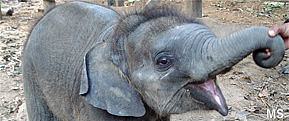 |
Nepal National Parks Chitwan |
|
 |
|
Animals
of riverbanks: Marsh Crocodiles
|

|
Surrounded
by marsh, meadows and forest, Ghodaghodi Lake, Nepal's lowest lowland lake
in the western part of the country, has long been known for its rich biodiversity
and wildlife. But years of heavy exploitation and poaching in and around
the lake have threatened the survival of many important species, including
turtles and crocodiles.
Recognizing
the threat, WWF and the government of Nepal - through the Terai Arc Landscape
(TAL) Programme - initiated a project at the lake to improve the habitat
of the marsh mugger crocodile.
"The
marsh mugger is not among the most endearing species but they are an important
part of wetland biodiversity," said Neera Shrestha Pradhan, WWF Nepal's
Freshwater Officer.
"That
is why we, together with local communities living near the lake, have built
a reinforced sandbank. We hope this will become a suitable nesting site
for the crocodiles."
Recently,
a local monitoring team found a number of footprints at the site, evidence
that the sandbank is already being used by the marsh muggers for basking
in the sun, and potentially, for nesting.
Ghodaghodi
Lake is one of four Ramsar wetland sites of international importance in
Nepal, and is part of the Terai Arc Landscape. Located in the shadow of
the Himalayas, the Terai Arc covers 5 million hectares - from Nepal's Bagmati
River in the east to India's Yamuna River in the west. It provides critical
habitat for greater one-horned rhinoceros, royal Bengal tigers, Asian elephants,
80 other mammal species, 47 reptile and amphibian species, 556 bird species,
and more then 2,100 flowering plant species.
As
part of the Terai Arc Landscape (TAL) Programme, WWF and its partners are
working to restore and reconnect 11 national parks in Nepal and India to
create one continuous landscape.
Improving
the habitat for the marsh mugger crocodile is just one small part of species
conservation and restoring the landscape.
In
addition to reinforcing crocodile habitat, WWF has helped a local youth
form a community-based anti-poaching operation, the first of its kind in
the region, to protect the wetlands and its resources.
"This
group is actively involved in preventing poaching and encroachment within
and around Lake Ghodaghodi," Pradhan added.
The
anti-poaching group has confiscated over 800 fish hooks, three boats and
nearly 200 gill nets. Several local poachers have also voluntarily surrendered
their spears and even dugout canoes.
 The marsh mugger crocodile (Crocodylus palustris) is found throughout
the Indian subcontinent and the surrounding countries of Nepal, as well
as India, Pakistan, Bangladesh and Iran. Sometimes exceeding 15ft in length,
the crocodile, eats fish, other reptiles, and small and large mammals. The marsh mugger crocodile (Crocodylus palustris) is found throughout
the Indian subcontinent and the surrounding countries of Nepal, as well
as India, Pakistan, Bangladesh and Iran. Sometimes exceeding 15ft in length,
the crocodile, eats fish, other reptiles, and small and large mammals.
 The Convention on Wetlands is an intergovernmental treaty providing the
framework for national action and international cooperation for the conservation
of wetlands and their resources. There are presently 152 parties to the
convention, with 1,611 wetland sites, totaling 145.2 million hectares,
designated for inclusion in the Ramsar List of Wetlands of International
Importance. The Convention on Wetlands is an intergovernmental treaty providing the
framework for national action and international cooperation for the conservation
of wetlands and their resources. There are presently 152 parties to the
convention, with 1,611 wetland sites, totaling 145.2 million hectares,
designated for inclusion in the Ramsar List of Wetlands of International
Importance.
 Nepal presently has four sites designated as Wetlands of International
Importance, with a surface area of 23,488 hectares. They include the Ghodaghodi
Lake Area, as well as Beeshazar and Associated Lakes, Jagadishpur Reservoir
and Koshi Tappu. Nepal presently has four sites designated as Wetlands of International
Importance, with a surface area of 23,488 hectares. They include the Ghodaghodi
Lake Area, as well as Beeshazar and Associated Lakes, Jagadishpur Reservoir
and Koshi Tappu.
| Source:
WWF Nepal, 18 Aug 2006 |
 |
top
|
Links
|
 |
 |
 |
External
links |
|



![]() The marsh mugger crocodile (Crocodylus palustris) is found throughout
the Indian subcontinent and the surrounding countries of Nepal, as well
as India, Pakistan, Bangladesh and Iran. Sometimes exceeding 15ft in length,
the crocodile, eats fish, other reptiles, and small and large mammals.
The marsh mugger crocodile (Crocodylus palustris) is found throughout
the Indian subcontinent and the surrounding countries of Nepal, as well
as India, Pakistan, Bangladesh and Iran. Sometimes exceeding 15ft in length,
the crocodile, eats fish, other reptiles, and small and large mammals.
![]() The Convention on Wetlands is an intergovernmental treaty providing the
framework for national action and international cooperation for the conservation
of wetlands and their resources. There are presently 152 parties to the
convention, with 1,611 wetland sites, totaling 145.2 million hectares,
designated for inclusion in the Ramsar List of Wetlands of International
Importance.
The Convention on Wetlands is an intergovernmental treaty providing the
framework for national action and international cooperation for the conservation
of wetlands and their resources. There are presently 152 parties to the
convention, with 1,611 wetland sites, totaling 145.2 million hectares,
designated for inclusion in the Ramsar List of Wetlands of International
Importance.
![]() Nepal presently has four sites designated as Wetlands of International
Importance, with a surface area of 23,488 hectares. They include the Ghodaghodi
Lake Area, as well as Beeshazar and Associated Lakes, Jagadishpur Reservoir
and Koshi Tappu.
Nepal presently has four sites designated as Wetlands of International
Importance, with a surface area of 23,488 hectares. They include the Ghodaghodi
Lake Area, as well as Beeshazar and Associated Lakes, Jagadishpur Reservoir
and Koshi Tappu.
